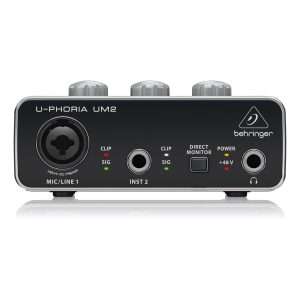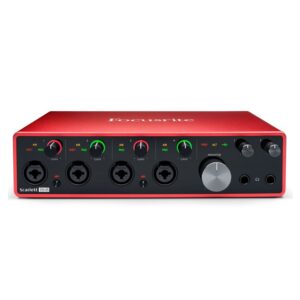Universal Audio Apollo Twin X DUO Thunderbolt 3 Audio Interface
The Apollo Twin X DUO is a high‑performance desktop interface from UA, sitting between the Solo and QUAD in terms of DSP power. “DUO” means it has two SHARC DSP cores (UAD‑2 DUO) for real‑time plug‑ins. It uses Thunderbolt 3 for connection (so very low latency) and features Unison mic preamps, high‑quality AD/DA conversion, and a versatile set of I/O.
The Universal Audio Apollo Twin X DUO is a professional-grade, desktop Thunderbolt 3 audio interface that brings the elite sound quality and real-time UAD processing of Universal Audio’s flagship Apollo interfaces to a more compact form factor. It is an ideal choice for musicians, producers, and engineers who need a powerful recording solution for their home or project studio.
Key Features and Highlights:
- Unison Mic Preamps: This is a hallmark of the Apollo line. The Twin X DUO features two Unison-enabled preamps. This is a unique hardware-software integration that allows you to “track through” authentic emulations of legendary analog preamps from brands like Neve, API, and Manley. The technology physically reconfigures the preamp’s impedance and gain staging to match the original hardware, providing a truly authentic tone and feel.
- DUO Core DSP Processing: The “DUO” in the name signifies that this interface is equipped with two dedicated SHARC DSP processors. This onboard processing power is a major advantage, as it allows you to run a significant number of UAD plugins in real-time during both tracking and mixing. This frees up your computer’s CPU and allows you to monitor with professional-grade effects (like compressors, EQs, and reverbs) with near-zero latency.
- Elite-Class AD/DA Conversion: The Apollo Twin X DUO uses the same high-end A/D and D/A converters found in the flagship Apollo X rackmount interfaces. This provides a massive dynamic range of up to 127 dB, ensuring that your recordings are captured and monitored with pristine clarity and incredible detail.
- Thunderbolt 3 Connectivity: The interface uses a high-speed Thunderbolt 3 connection for a reliable and low-latency connection to both Mac and Windows computers. This powerful connection also allows the Twin X DUO to be bus-powered, meaning it draws all the power it needs from the computer, eliminating the need for an external power supply.
- Extensive I/O: The Twin X DUO offers a 10-in/6-out configuration, including:
- 2 x Unison-enabled XLR/TRS combo inputs
- 1 x Front-panel Hi-Z instrument input
- 4 x Balanced line outputs for connecting to studio monitors and outboard gear
- 1 x ADAT/S/PDIF optical input for adding up to 8 more channels
- 1 x Dedicated headphone output
- Bundled Software: The Apollo Twin X DUO comes with a valuable software suite. The standard “Realtime Analog Classics” bundle includes essential plugins like the UA 610-B Tube Preamp, Pultec EQs, and LA-2A and 1176 compressors. The “Heritage Edition” adds a curated suite of five additional premium UAD plugins. The interface also integrates seamlessly with Universal Audio’s free LUNA Recording System for Mac.
Apollo Twin X DUO vs. QUAD
The main difference between the Apollo Twin X DUO and the QUAD is the amount of onboard DSP processing power.
- DUO Core: Has two SHARC DSP chips.
- QUAD Core: Has four SHARC DSP chips.
While both interfaces offer the same high-quality audio conversion and Unison preamps, the QUAD version gives you double the processing power. This allows you to run more plugins simultaneously, both during tracking (for more complex signal chains) and especially during mixing (for applying plugins to many tracks). For many users, the DUO is sufficient for a few plugins on a few tracks, but if you anticipate using a large number of high-end UAD plugins in your mixes, the QUAD is a better long-term investment.
Based on 0 reviews
Be the first to review “Universal Audio Apollo Twin X DUO Thunderbolt 3 Audio Interface”
You must be logged in to post a review.








There are no reviews yet.